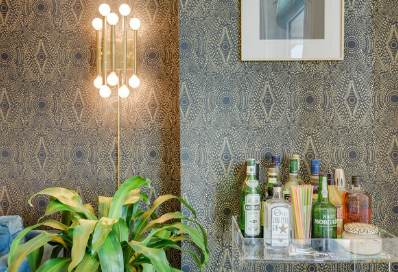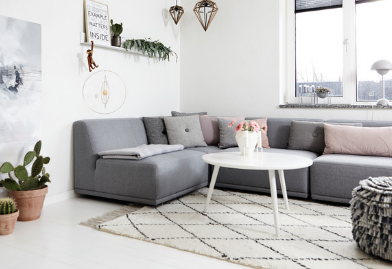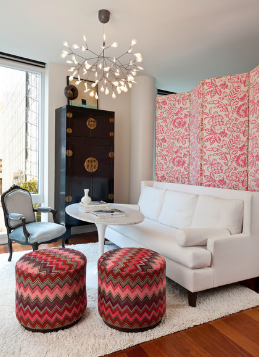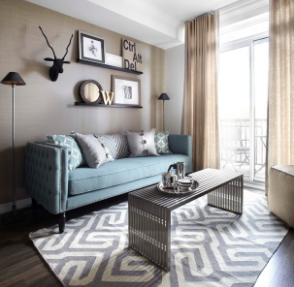

Just because you’re in a small space doesn’t mean you can’t host a large party. To help you make your space function well entertaining – while still working for your daily routine – here are some of my favorite tips on furniture, styling, and even secret crowd control. No matter the size of your home, you can enjoy the night of a lifetime.

As with any small space, a compact entertainment area can feel bigger by using lots of light colors on the walls, especially bright whites. However, entertainment spaces are sometimes best felt comfortable and lively, rather than airy and minimalist.

Don’t be afraid to use dark or dramatic tones on the wall, either as a main color or as an accent color, to help create a more intimate atmosphere. You can also contrast dark or bright tones with light, light colors. These often recede, creating a deep interplay that makes the room feel bigger and more vibrant.
Refer to the color scheme of your favorite restaurant, and keep in mind that any shade will look different in the evening light than it would in bright daylight. Place paint chips and observe the color reading at different times of the day.

When it comes to lighting, it’s especially important to have a good lighting scheme in your entertainment space that can be controlled to create the right atmosphere. Even in a small space, you can’t expect a single luminaire in the center of the ceiling to do it all.
Multi-light wall lights, such as the smart plug-in fixtures shown here, can help add lighting at angles that fit your face, making your space and your guests look their best. Use dimmable fixtures, or simply include a couple of smaller lights so you can boost the brightness or soft glow as needed.

In addition to lighting, mirrors and light-toned decorations can also make a small space feel pleasant rather than claustrophobic. Objects such as white picture frames or artwork give a visual break, while mirrors extend the line of sight.
Mirrors also give people the chance to sneak a glimpse at another party guest – or just check for spinach in their teeth.

When entertaining, you’ll want to be able to accommodate a lot of people. Another day, you may want a comfortable place to decompress on your own (or even take a sneak nap). Start your furniture plan with a large sofa and you’ll be ready for both. When it’s time to receive guests, you can sit side by side on the couch with your good friends and rest comfortably for the rest of the week.
If you want the most seats, an armless sofa can free up valuable space to squeeze one or two more people at either end. You can then add a pillow as an armrest or backrest if you wish.
Alternatively, a modern sofa with wide armrests like this one can provide a casual place for people to rest while chatting, or an extra place to grab a drink or snack. Just make sure to provide a tray with an edge to catch the spill. (Dark interiors that hide stains don’t hurt either.)

Of course, a large sofa can only accommodate a limited number of guests – some people may prefer their own seats. To maximize seating, I like to balance the large sofa with 16- to 20-inch mid-century modern side chairs. They add a bit of classicism without taking up too much space.
You can keep some in the main recreation room or take some out of another room, such as a dining room or even a patio, if you want.

In addition to needing a place to sit, your guests need space to move around, stretch their legs, and even dance. Avoiding bulky tables and furniture to obstruct circulation will help make small spaces feel more open.
Try using a long-legged option that won’t get in the way of foot extension instead of a thick coffee table. Better yet, use several small tables that can be moved out of the way or rearranged as needed.

In general, having an eclectic combination of chairs allows you to cope with different entertainment scenarios, so you can feel free to break out of the typical box of a “one sofa, two chairs” living room combination. Adding some small stools can give you extra seating or a table as needed, and a high-side table can be used as a compact dining table or minibar. Multi-functional parts like these give you a variety of options to tuck them aside when you don’t need them.

Although spaces vary, oval or round tables are often ideal for small spaces that need to accommodate a flexible number of guests. The rounded edges allow you to get guests seated without having to bump anyone into a corner. Round tables also make it easier to accommodate an odd number of guests without looking “out of place”.
Just like in the living room, using a bench or banquet chair mixed with a standard dining chair will allow you to have room for some extra guests (especially small children) while allowing others to choose a single seat.

Wall lamps are also a great solution for adding a little lighting to a small dining table or other key areas. Choose a product that mounts on a rocker arm and can be pushed against a wall if you move the table to make room for standing.

If you don’t have space for a dedicated dining table, a convertible coffee table is a convenient solution. They usually fold into a larger surface, have height-adjustable legs, and can be converted from a coffee table to a dining table with just a few clicks.

Whether you’re partying 10 or 100 people, you can always use a little crowd control. Creating a natural justification for people to circulate in a space, rather than congregating in one area, can lead to better traffic flow and more communication.
One of the best ways to smartly get people moving is to place the drink station (or food station in the buffet scene) away from obvious gathering points, such as a kitchen island or main seating. Setting up a small bar like this in a corner away from traffic allows guests to stay circulatory instead of stopping in the hallway or doorway.

In addition to controlling the lighting, you also want to be able to control the poor acoustics at the party. If you don’t take steps to reduce the noise, then all chats will create unpleasant noise.
Adding fabric will greatly reduce echoes in a small space, so try adding curtains, rugs, upholstery, or canvas artwork to break up hard surfaces and reduce noise to a dull roar.

Ultimately, no matter the size of the room, one of the most important décor decisions is to consider the comfort of the guests when choosing what to include. If guests feel like they have to move and act too carefully to avoid ruining your original surface, they will never be able to relax. Choosing fabrics that are easy to care for and arranging the décor in a more casual way will help make your guests feel at ease while creating a sophisticated style and leaving plenty of room for your personality to shine through.
So, if you plan to host guests often, perhaps it’s best to reconsider white sofas, delicate rugs, or antique vases and go for a more casual style, or let the party be held in someone else’s home.